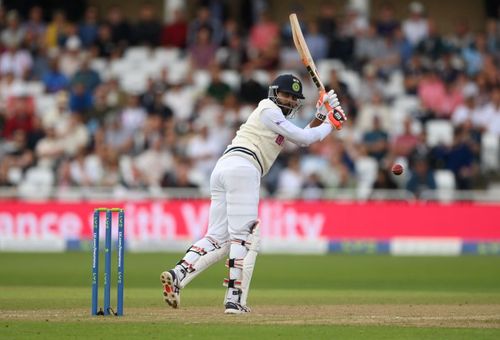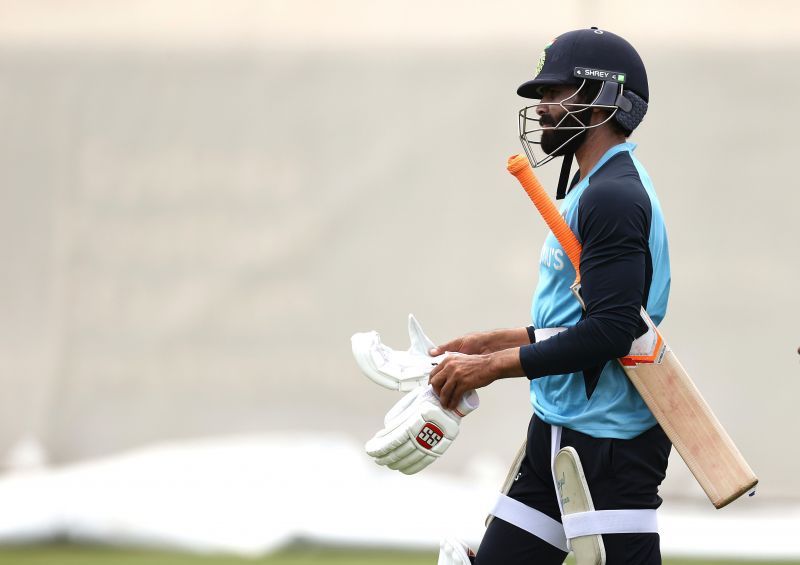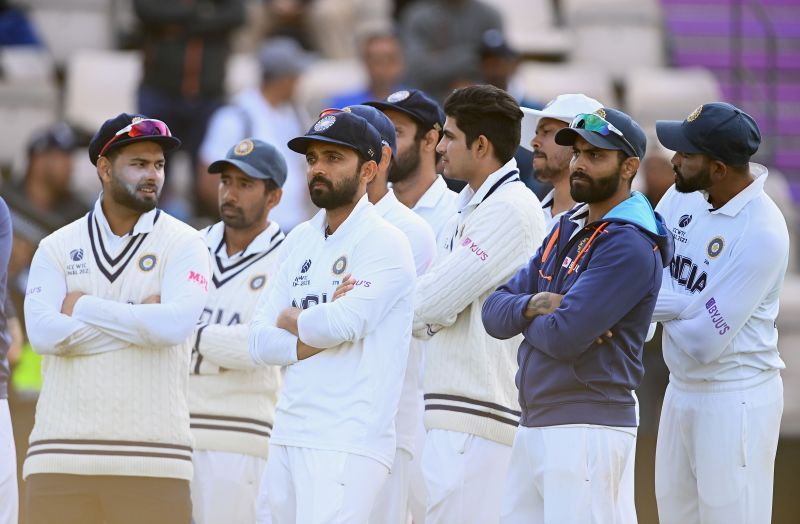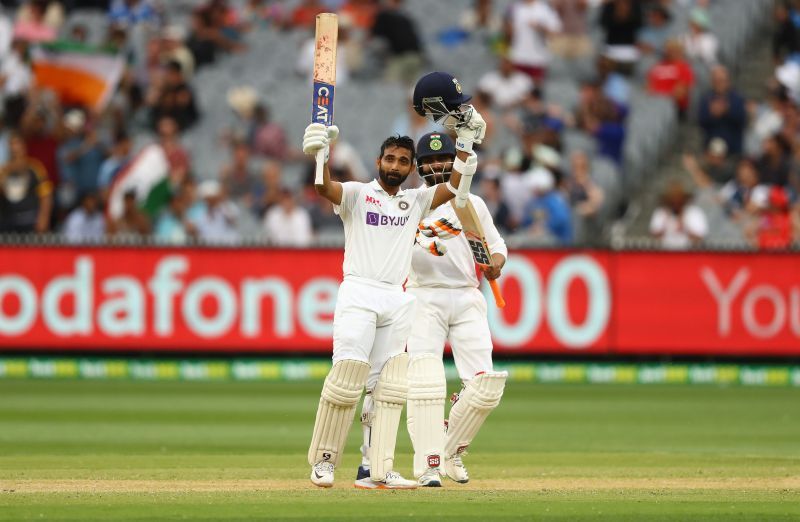
Promoting Ravindra Jadeja in the batting order might be the universal answer to India's Test selection woes

When Mike Atherton and Michael Holding were on air during Day 3 of the first Test between India and England, they made an interesting reference to Ravi Shastri.
The commentary duo brought up Shastri's promotion in the batting order for a tour of the West Indies back in the 80s. The then bowling all-rounder had opened the innings, with the rest of the Indian batsmen supposedly not keen on facing the famed Caribbean pace quartet with a brand new ball.
Shastri, for his part, didn't seem too enthused about being mentioned on the broadcast. With an earpiece informing him of the commentators' interest in him, the Indian head coach waved away the conversation. But the short, easy-to-miss incident has given birth to several interesting questions.
Could India have a lot to gain by promoting another left-arm spinner, Ravindra Jadeja, up the order? Maybe not to an opening role, but certainly higher than the No. 7 position he's currently batting at?
Ravindra Jadeja is one of the best Test batsmen in the current Indian team

In a team consisting of players like Cheteshwar Pujara, Ajinkya Rahane, Rishabh Pant and Virat Kohli, Ravindra Jadeja may not immediately come to mind when you think about the best Test batsmen. But he's right up there. In fact, in certain categories, he's clear of every marquee batsman in the team.
Since the start of 2018, no Indian batsman has averaged more than Jadeja in away Tests. The southpaw's average of 41.90 in 15 innings is better than Kohli (40.83 in 36), Pant (37.46 in 28), Pujara (34.79 in 40) and Rahane (34.16 in 38). Jadeja has also averaged more than Hanuma Vihari and Rohit Sharma, who've played a similar number of innings.
Yes, his sample size is small when compared to Kohli, Pujara and Rahane. But Jadeja has also been in far more challenging situations where he's had to balance attack and defense while batting with the tail, as well as counter the second new ball. The 32-year-old has been in and out of the team due to selection dilemmas and the odd injury, but he's still managed to perform whenever called upon.
Jadeja has always been an excellent player of spin. Moreover, India don't really have any selection problems in home conditions, with two pacers often more than enough. His stats away from home, which should be the deciding factor in him being considered for a promotion, paint a clear picture.
On the last tour of Australia, in the 2020-21 summer Down Under, Jadeja scored 57 and 28* in his only two innings. Before that, in a solitary Test in New Zealand, he scored 9 and 16*. He also had scores of 86*, 81 and 58 in the five overseas Tests he played in 2018 and 2019, along with his only international hundred (against West Indies at home).
Jadeja isn't free of issues altogether. Some teams have targeted him with short-pitched bowling, while others have tried to exploit his tendency to play around his front pad on the defense. However, his technique is certainly good enough to play as a specialist batsman. And to sweeten the pot...
Jadeja's promotion would be killing two birds with one stone

A promotion for Ravindra Jadeja could be the masterkey that unlocks all doors; the elixir that heals all ailments.
At the moment, India have two main problems - the middle order isn't firing, and the absence of a proper pace-bowling all-rounder means that a fourth quick has to replace either Ravichandran Ashwin or Jadeja overseas. India need a way to squeeze Ashwin into the team while retaining four pacers.
Kohli, as captain and arguably the best batsman in the world, is undroppable. But Pujara and Rahane aren't privy to the same sense of security. Can Kohli move up one place to No. 3, with Jadeja batting at No. 5 below Rahane? Or can Jadeja bat at No. 5 at the expense of Rahane?
Experts like Nasser Hussain have claimed that No. 6 is too high for Rishabh Pant in England, so Jadeja could even move just one place higher. While that alone wouldn't serve the goal of reinforcing the middle order, Ashwin could bat at No. 6 ahead of Pant.
This idea might seem like India are sacrificing their batting completely. But have Pujara and Rahane done enough to justify their place in the side? Their average over the last two years has been in the mid-twenties and they've found strange ways to get out. Are India really much worse off without one or both of them, considering the wicket-taking threat Ashwin would bring?
By squeezing Jadeja into the top six, India could not only avail the services of a second spinner but also ensure that a batsman who's actually performing is given ample opportunities to score big runs.
England are able to go in with just four pacers because they know Joe Root can roll his arm over. India can take a leaf out of their book, using Ashwin as the premier spinner overseas and Jadeja as a batting all-rounder who can bowl if and when needed.
Virat Kohli may not need two spinners at certain venues, but Ashwin and Jadeja are such value additions that any way to field them both must be entertained.
Time for Ravindra Jadeja 3.0?

Ravindra Jadeja's India career can be broken up into two distinct phases. In the first period, he struggled to fulfill his potential with the bat, leading to numerous jibes at his domestic triple centuries. In the second, he used his natural counter-attacking game to play a series of matchwinning innings, effectively coming of age as a batsman.
Now, it could be time for Ravindra Jadeja 3.0 - the batsman who can bat in the top five in Test cricket. The 32-year-old has been used in a similar role before at home, when Wriddhiman Saha's batting didn't quite inspire confidence in the Indian team's management. But there is a real case for him to permanently seal the spot.
From a strictly tactical perspective, Jadeja at No. 5 is an appealing prospect. He could be the best of the two contrasting worlds that are Ajinkya Rahane and Rishabh Pant. While Pant is easily the first-choice keeper, India could use someone dynamic and defensive in equal measure - as well as consistent - instead of Rahane.
Younger batsmen like Mayank Agarwal, KL Rahul, Shubman Gill and Hanuma Vihari are peering into the playing XI from behind the curtain, which is slowly pulling open to accommodate the possibility of their inclusion.
But the universal answer to India's Test selection woes, especially away from home, might be staring at them in the form of a promotion for a 32-year-old all-rounder who is reborn with the bat, handy with the ball and electric on the field.